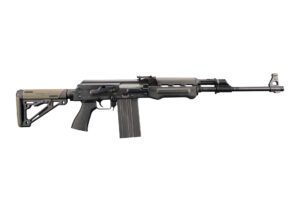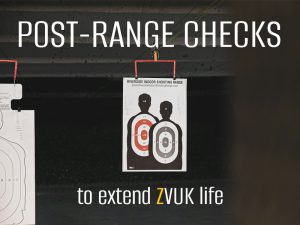You packed the thermos, zipped the parka, and now the forecast says “ice planet.” Perfect. The Zastava ZVUK titanium AK suppressor loves crisp air as much as you do, and winter gives you a few bonus tricks if you set up right. Below you’ll find a no-nonsense guide to running ZVUK in snow with zero drama and plenty of grin.
Why Titanium Wins In The Cold
ZVUK features a titanium build that repels moisture and road-salt mist. Titanium forms a stable oxide layer, so wet snow and fog don’t scare it the way they do lesser metals.
Ti-6Al-4V also retains its strength at low temperatures; aerospace teams select it for cryogenic duty for that exact reason. That combo (light weight, high strength, and corrosion resistance) fits winter field use like a glove.
ZVUK’s design also prioritizes smooth gas control. You get a calmer action and a more pleasant shooting impulse, even when frigid air thickens gas flow. Zastava’s own overview highlights weight reduction, heat management, and smart gas behavior as core goals for its titanium AK suppressor.
Cold-Weather Setup: Threads, Torque, Alignment
Cold metal contracts. That reality pushes you to treat threads with a touch of care. Use proper torque, seat the can fully, and verify bore alignment on your Zastava platform before the first shot.
Zastava’s alignment rods, offered in 7.62/.30-cal and 5.56/.223, make that check fast and precise. Slide the correct rod down the bore with the mounted ZVUK; the rod should pass cleanly through the aperture with daylight to spare. If it looks off, correct the mount before you send any rounds.
Titanium loves to save ounces but can seize if you abuse dry threads under load. A tiny smear of high-temp anti-seize on the interface helps avoid galling between titanium and steel, especially after a heat cycle that ends in a deep freeze.
Materials data on Ti-6Al-4V notes a tendency to seize under sliding contact, exactly why a dab of anti-seize pays off. Wipe any excess; keep it off the bore.
Moisture Control: Snow And Fog Playbook
Frost doesn’t hurt gear; condensation does. The classic trap looks like this: you run the rifle outside, then you bring it into a warm truck or cabin. Moisture forms on every cold surface, including internal parts.
You step back into sub-zero air, and that moisture refreezes. The fix stays simple and proven: if the plan includes another cold session soon, leave the rifle and ZVUK in a sheltered unheated space so the system stays cold and dry.
If you must bring it inside, let it “sweat” near the floor for a bit, then dry and lube lightly before the next cold run. This mirrors long-standing winter guidance from military trainers and armorer notes.
Fresh snow can pack into a muzzle faster than you think. Before you mount ZVUK, brush the crown and threads. Before you shoot, check the exit aperture. That two-second habit saves a day.
Sub-Zero Start: First Shots And Zero
First rounds through a truly cold can may feel tame because cold titanium dumps what little heat it gains into the winter air very fast. That rapid cool-off helps keep mirage low and sight pictures crisp.
You may see a hair of point-of-impact shift as the entire system settles from “dead cold” to “now we’re awake.” Fire a short confirmation group at the start of a winter session and lock in your data. ZVUK’s gas behavior aims for a smooth, repeatable impulse, which makes any cold-to-warm shift easy to confirm and note.
Field Habits That Keep You Smiling
- Pack a Brush and Lens Pen. Knock snow off threads, sights, and the ZVUK aperture before you shoot.
- Cap It Between Strings. A simple cover or cap keeps swirling flakes out of the bore and suppressor.
- Use The Right Layers. A glove with grip pads handles cold metal without slipping.
- Keep A Soft Cloth In The Stock Pouch. Wipe meltwater fast; water that never sits never freezes.
- Stage Your Rifle Smart. If you plan a second cold session, stage the rifle and ZVUK in a sheltered, unheated spot to prevent condensation cycles.
- Confirm Alignment After A Bump. Snow, brush, and a sled can twist a mount. Drop in the Zastava rod, verify, and go.
Lube And Clean For Real Winter
Thin oil wins in the cold. Heavy grease can stiffen in sub-zero temps. After a day outside, dry the can’s exterior and the mount, then apply a light coat to steel interfaces to block flash rust.
If you cycled the rifle from cold to warm, clean it after the condensation window passes so you don’t lock moisture inside. These habits track with long-running cold-weather maintenance guidance from armorer notes and technical trainers.
If your setup uses any modular adaptor from the Zastava lineup, torque to spec and re-check after the first magazine; winter gloves can trick your feel for “snug.” Zastava lists a HUB adaptor in the suppressor family (use cases differ by rifle), so treat that interface with the same cold-weather care as the primary mount.
Ammo, Cases, And Carry
Snow invites grit. Keep a handful of cartridges in a pocket pouch, not loose in a wet shell. Inspect mouth crimps and primers after a dunk. If a round looks sketchy, swap it for a fresh one. Dry magazines before storage.
Your ZVUK suppressor will thank you with consistent tone and recoil feel as the rifle cycles cleanly.
The Bottom Line
Winter rewards good habits. Titanium construction, smart gas control, and Zastava’s own support gear (alignment rods, adaptors) give ZVUK a natural edge when frost moves in. Set the mount right, manage moisture, and your cold-day notes will read like a victory lap.
All upside, no drama. As it should be with ZastavaArms.



